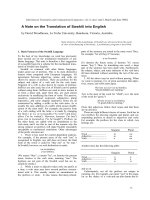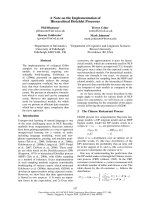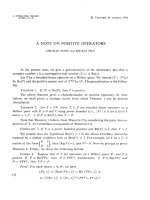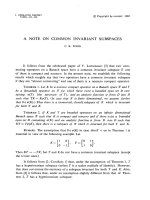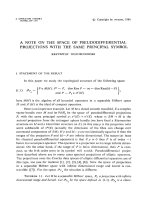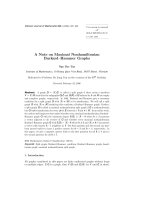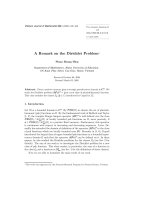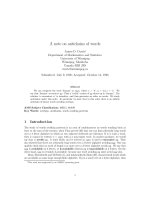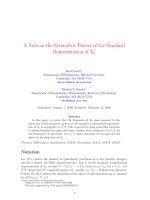Báo cáo toán học: "A Note on the Number of Hamiltonian Paths in Strong Tournaments" ppsx
Bạn đang xem bản rút gọn của tài liệu. Xem và tải ngay bản đầy đủ của tài liệu tại đây (73.42 KB, 4 trang )
A Note on the Number of Hamiltonian Paths in
Strong Tournaments
Arthur H. Busch
Department of Mathematics
Lehigh University, Bethlehem PA 18105
Submitted: Sep 20, 2005; Accepted: Jan 18, 2006; Published: Feb 1, 2006
Mathematics Subject Classifications: 05C20, 05C38
Abstract
We prove that the minimum number of distinct hamiltonian paths in a strong
tournament of order n is 5
n−1
3
. A known construction shows this number is best
possible when n ≡ 1 mod 3 and gives similar minimal values for n congruent to 0
and 2 modulo 3.
A tournament T =(V, A) is an oriented complete graph. Let h
p
(T )bethenumber
of distinct hamiltonian paths in T (i.e., directed paths that include every vertex of V ).
It is well known that h
P
(T ) = 1 if and only if T is transitive, and R´edei [3] showed
that h
p
(T ) is always odd. More generally, if T is reducible (i.e., not strongly connected),
then there exists a set A ⊂ V such that every vertex of A dominates every vertex of
V \ A. If we denote the subtournament induced on a set S as T [S], then it is easy
to see that h
p
(T )=h
p
(T [A]) · h
p
(T [V \ A]). Clearly, this process can be repeated to
obtain h
p
(T )=h
p
(T [A
1
]) · h
p
(T [A
2
]) ···h
p
(T [A
t
]) where T [A
1
], ,T[A
t
] are the strong
components of T . As a result, we generally consider h
p
(T ) for strong tournaments T .
In particular, we wish to find the minimal value of h
p
(T )asT ranges over all strong
tournaments of order n. Moon [1] bounded this value above and below with the following
result.
Theorem (Moon [1]). Let h
p
(n) be the minimum number of distinct hamiltonian paths
in a strong tournament of order n ≥ 3. Then
α
n−1
≤ h
p
(n) ≤
3 ·β
n−3
≈ 1.026 · β
n−1
for n ≡ 0mod3
β
n−1
for n ≡ 1mod3
9 · β
n−5
≈ 1.053 · β
n−1
for n ≡ 2mod3
where α =
4
√
6 ≈ 1.565 and β =
3
√
5 ≈ 1.710.
the electronic journal of combinatorics 13 (2006), #N3 1
This lower bound was used by Thomassen [2] to establish a lower bound for the number
of hamiltonian cycles in 2-connected tournaments.
Theorem (Thomassen [2]). Every 2-connected tournament of order n has at least
α
(
n
32
−1)
distinct hamiltonian cycles.
We shall prove that the upper bound for h
p
(n) by Moon is, in fact, best possible, and
consequently improve the lower bound on hamiltonian cycles in 2-connected tournaments
found by Thomassen.
We will call a tournament T nearly transitive when V (T ) can be ordered v
1
,v
2
, ,v
n
such that v
n
→ v
1
and all other arcs are of the form v
i
→ v
j
with i<j. In other words,
reversing the arc v
n
→ v
1
gives the transitive tournament of order n. As noted by Moon
[1], there is a bijection between partitions of V \{v
1
,v
n
} and hamiltonian paths that
include the arc v
n
→ v
1
, and there is a unique hamiltonian path of T that avoids this arc.
Hence, there are 2
n−2
+ 1 distinct hamiltonian paths in a nearly transitive tournament of
order n.
Lemma 1. Let T be a strong tournament of order n ≥ 5. Then, either T is nearly
transitive, or there exist sets A ⊂ V and B ⊂ V such that
•|A|≥3 and |B|≥3.
• T[A] and T [B] are both strong tournaments.
•|A ∩ B| =1and A ∪B = V .
Proof. First, assume that T is 2-connected. Choose vertices C = {x
0
,x
1
,x
2
} such that
T [C] is strong. Since T is 2-connected, every vertex of T has at least two in-neighbors
and at least two out-neighbors. As each vertex x
i
has a single in- and out-neighbor on
the cycle C, we conclude that each x
i
beats some vertex in V \ C andisbeatenbya
vertex in V \C.IfT −C is strong, then A = C and B = V \{x
0
,x
1
} satisfy the lemma.
Otherwise, let W
1
(resp. W
t
) be the set of vertices in the initial (resp. terminal) strong
component of T −C.AsT is 2-connected, at least two vertices of C have in-neighbors in
W
t
, and at least two vertices of C have out-neighbors in W
1
. Thus, at least one vertex of
C has both in-neighbors in W
t
and out-neighbors in W
1
. Without loss of generality, let
this vertex be x
0
.ThenC and V \{x
1
,x
2
} satisfy the lemma.
Next, assume that T contains a vertex v such that T − v is not strong and that no
sets A and B satisfy the lemma. Let t be the number of strong components of T − v
and let W
i
be the set of vertices in the i
th
strong component. If |W
1
|≥3, then choose
a vertex w ∈ W
1
such that v → w.ThenA = W
1
and B =
t
i=2
W
i
∪{v, w} satisfy
the lemma. Similarly, if |W
t
|≥3, then A =
t−1
i=1
W
i
∪{v, w} and B = W
t
satisfy
the lemma for any w ∈ W
t
such that w → v in T . Hence, since there does not exist
a strong tournament on two vertices, we can assume that W
1
= {w
1
} and W
t
= {w
t
}
with v → w
1
and w
t
→ v.Now,letW =
t−1
i=2
W
i
.IfT [W ] contains a cyclic triple, let
A = {u
1
,u
2
,u
3
}⊆W with T [A] cyclic. In this case A and B = V \{u
2
,u
3
} are sets which
satisfy the lemma. So we can assume that T [W ] and hence T − v are both transitive.
the electronic journal of combinatorics 13 (2006), #N3 2
Finally, let W
−
= W ∩ N
−
(v)andW
+
= W ∩ N
+
(v). If W
+
= ∅ and W
−
= ∅,then
A = W
−
∪{w
1
,v} and B = W
+
∪{w
t
,v} satisfy the lemma. Otherwise, either W
+
= ∅
or W
−
= ∅.IfW
+
= ∅,thenN
+
(v)={w
1
} and reversing the arc vw
1
gives a transitive
tournament of order n,andifW
−
= ∅, N
−
(v)={w
t
} and a transitive tournament of
order n is obtained by reversing the arc w
t
v. In both cases, this implies that T is nearly
transitive.
Our next lemma is probably widely known. The proof is an easy inductive extension
of the well known fact that in a tournament, every vertex v not on a given path P can be
inserted into P . We include the proof for completeness.
Lemma 2. Let P = v
1
→ v
2
→ ··· → v
k
and Q = u
1
→ u
2
→ ··· → u
m
be vertex
disjoint paths in a tournament T . Then there exists a path R in T such that
• V (R)=V (P ) ∪V (Q)
• For all 1 ≤ i<j≤ k, v
i
precedes v
j
on R
• For all 1 ≤ i<j≤ m, u
i
precedes u
j
on R.
Proof. Note that we allow the special case where m = 0; in this case the path Q is a path
on 0 vertices, and R = P satisfies the lemma trivially.
The remainder of the proof is by induction on m.Form =1,leti be the minimal
index such that u
1
→ v
i
.Ifnosuchi exists then R = v
1
→···→v
k
→ u
1
.Ifi =1,then
R = u
1
→ v
1
→···→v
k
. In all other cases, R = v
1
→···→v
i−1
→ u
1
→ v
i
→···→v
k
.
So we assume the result for all paths Q
of order at most m−1. Let Q
= u
1
u
2
···u
m−1
and
apply the induction hypothesis using the paths P and Q
to obtain a path R
satisfying
the lemma. Next, we repeat the above argument with the portion of R
beginning at u
m−1
and the vertex u
m
.
Theorem 1. Let h
p
(n) be the minimum number of distinct hamiltonian paths in a strong
tournament of order n. Then
h
p
(n) ≥
3 · β
n−3
≈ 1.026 · β
n−1
for n ≡ 0mod3
β
n−1
for n ≡ 1mod3
9 · β
n−5
≈ 1.053 · β
n−1
for n ≡ 2mod3
where β =
3
√
5 ≈ 1.710.
Proof. The proof is by induction. The result is easily verified for n =3andn =4,andas
observed by Thomassen [2], h
p
(5) = 9. So assume the result for all tournaments of order
at most n − 1andletT be a strong tournament of order n ≥ 6.
As T is strong, by Lemma 1 there are two possibilities. If T is a nearly transitive
tournament. Then h
p
(T )=2
n−2
+1, and for n ≥ 6, this value exceeds 9·β
n−5
. Otherwise,
there exist sets A and B such that T [A]andT [B] are strong tournaments with |A| = a ≥ 3,
the electronic journal of combinatorics 13 (2006), #N3 3
|B| = b ≥ 3, A ∪ B = V and |A ∩ B| =1. Let{v} = A ∩ B,andletH
A
= P
1
vP
2
be
a hamiltonian path of T [A], and H
B
= Q
1
vQ
2
a hamiltonian path of T [B]. We apply
Lemma 2 twice, and obtain paths R
1
and R
2
such that V (R
i
)=V (P
i
) ∪ V (Q
i
), and the
vertices of P
i
(resp. Q
i
)occurinthesameorderonR
i
as they do on P
i
(resp. Q
i
). Now
H = R
1
vR
2
is a hamiltonian path of T . Furthermore, distinct hamiltonian paths of T [A]
(resp. T [B]) give distinct hamiltonian paths of T . Hence by the induction hypothesis,
h
p
(T ) ≥ h
p
(T [A])h
p
(T [B]) ≥ β
a−1
β
b−1
≥ β
n−1
Furthermore, strict inequality holds unless a ≡ 1mod3andb ≡ 1mod3,which
implies that n ≡ 1 mod 3 as well. When n ≡ 2 mod 3, there are two cases, a ≡ b ≡ 0
mod 3 and without loss of generality a ≡ 2mod3andb ≡ 1 mod 3. Using the same
induction arguments above, both cases give h
p
(T ) ≥ 9·β
n−5
. Finally, in the case that n ≡ 0
mod 3, we again have two possibilities, a ≡ b ≡ 2 mod 3 and without loss of generality
a ≡ 1mod3andb ≡ 0 mod 3. In this case we find that h
p
(T ) ≥ min(81·β
n−9
, 3·β
n−3
)=
3 · β
n−3
.
The construction utilized by Moon [1] in Theorem gives the identical upper bound
for h
p
(n) and equality is established.
Corollary 1. Let h
p
(n) be the minimum number of distinct hamiltonian paths in a strong
tournament of order n. Then
h
p
(n)=
3 · β
n−3
≈ 1.026 · β
n−1
for n ≡ 0mod3
β
n−1
for n ≡ 1mod3
9 · β
n−5
≈ 1.053 · β
n−1
for n ≡ 2mod3
where β =
3
√
5 ≈ 1.710.
Additionally, this result improves Thomassen’s bound on hamiltonian cycles in 2-
connected tournaments.
Corollary 2. Every 2-connected tournament of order n has at least β
n
32
−1
distinct hamil-
tonian cycles, with β =
3
√
5 ≈ 1.710.
References
[1] J. W. Moon, The Minimum number of spanning paths in a strong tournament, Publ.
Math. Debrecen 19 (1972),101-104.
[2] C. Thomassen, On the number of Hamiltonian cycles in tournaments, Discrete Math.
31 (1980), no. 3, 315-323.
[3] L. Redei, Ein kombinatorischer Satz, Acta Litt. Szeged 7 (1934), 39-43.
the electronic journal of combinatorics 13 (2006), #N3 4
